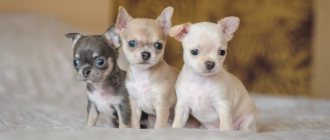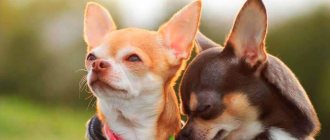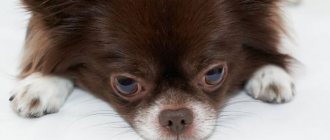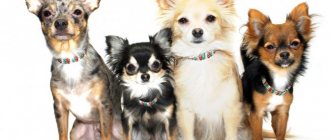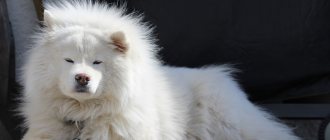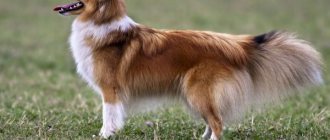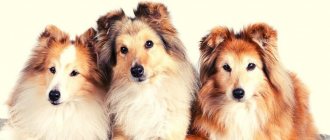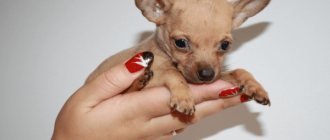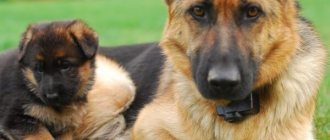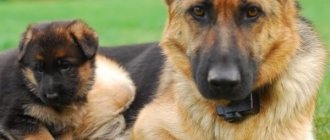How big will my Chihuahua puppy grow?
When will my Chihuahua stop growing? These are the questions every chi owner wants to know! The growth of this breed can be somewhat gradual. Therefore, sometimes the smallest puppy in the litter may outgrow its peers by the time they all reach the age of 1 year.
The best way to determine the future size of a Chihuahua is to study its pedigree. Size and other physical characteristics are hereditary. Genes passed on from the mother usually determine the size of the puppy. Although, looking back 2 or 3 generations will give you an even more accurate idea of its likely size.
Photos of what newborn puppies look like
Newborn Chihuahua puppies are born absolutely helpless: they take their first breath only after their mother has nursed them and freed them from mucus.
Their eyes and ears are tightly closed, and due to their extremely low weight, they are unable to maintain the desired body temperature on their own . It is vital for them to huddle close to their mother and littermates.
Newborn puppies have a reflex to turn towards a heat source, so for the first days they lie with their muzzle buried in their mother’s belly.
When do they open their eyes?
Two weeks after birth, puppies begin to open their eyes . At this time, they and their mother can be moved from the box bed to a more spacious playpen with a dedicated sleeping area.
Dimensions and weight
A newborn Chihuahua puppy easily fits in the palm of your hand and weighs from 70 to 160 grams . It is very rare, but it happens that there may be a “super-large” puppy in the litter, whose weight reaches up to 200 grams.
When do puppies' eyes open?
Newborn Chihuahuas are blind. They begin to see only when their eyelids are fully formed. Usually the development process takes one and a half to two weeks. The opening of the eyelids occurs slowly, starting from the inner corner of the eye and gradually moving to the outer corner. First, a thin slit appears, and then one eye opens completely, then the other. When puppies begin to see, they see the world around them blurred, distinguishing only light and darkness. Gradually they begin to see better, and after a week the vision becomes normal. Do not be alarmed by a cloudy iris or a veil on the eyeball. As soon as Chihuahuas are able to focus their gaze on surrounding objects, the veil disappears, and the color of the eyes changes as the puppies develop (by three months).
The period of 12-14 days for the babies’ eyes to open is approximate. The development process does not always go smoothly, but you cannot interfere with it. It is worth protecting newborns from bright light, and if purulent crusts appear on the eyelids, wipe them with an antiseptic. If there is severe suppuration and swelling, contact a veterinarian.
Early eye opening (up to 10 days) occurs due to individual characteristics or a long gestation period. Late sighting (after two weeks) is associated with developmental delay or illness.
Preparations for childbirth
From the fifty-seventh day of your Chihuahua's pregnancy, measure its temperature twice a day. You need to remove fish, meat, and salt from your diet. Within three days the dog may produce milk. Keep a bowl of clean water near the birthing box and change it periodically.
A day before giving birth, the dog begins to have a sticky, thick white discharge. Sometimes they may have a gray tint. At this time, it is necessary to begin measuring the Chihuahua's temperature as often as possible - before giving birth it should drop to 36 degrees. A harbinger of an early birth is the absence of movement of the puppies.
Before giving birth, prepare your pet: wash the dog’s body and genitals with warm water and a little soap. After this, treat the vagina and external organs with a solution of potassium permanganate in a ratio of 1 to 1000 milliliters of water. If you use furatsilin for this purpose, then its ratio to water should be 1 to 5000 milliliters.
How does it develop day by day in the first month?
In the first month of life, a Chihuahua puppy goes from a small and helpless lump in every sense to a cheerful toddler.
This formation occurs in several stages:
- From the second to the third day. Care should be taken to ensure that the mother does not accidentally crush the cubs or bury them in the blanket. In healthy puppies, the umbilical cord should dry out - if this does not happen, you should contact a veterinarian. Also, in the first three days, puppies must be taken to a veterinary clinic to have their dewclaws removed.
- From the tenth to the fifteenth day. Puppies grow rather sharp and long claws. They should be carefully cut so that the suckers do not scratch the mother’s delicate skin. On the 12th – 15th day, the babies’ eyes open.
- From 20 to 25 days. Babies make their first attempts to stand on their paws. The gait is very shaky, unstable, the head hangs.
- From 25 to 50 days. It's time for the first deworming. Puppies begin to develop hearing and teeth. In male dogs, the testicles droop. You can start the first feeding.
A one-month-old puppy must get used to interacting with people to avoid problems with socialization.
Tasty food is prohibited
Every Chihuahua owner needs to understand that what a person can eat is not always allowed for a puppy, or even an adult dog. Therefore, do not feed your favorite dog a tasty treat from the common table and do not accustom him to begging:
- do not give sugar, cookies and confectionery, especially ice cream, cakes, condensed milk;
- salt - in a minimal amount, it should be under-salted;
- feeding does not involve experimenting with bones; small fish ones are especially dangerous, as they can damage the baby’s internal organs and the esophagus;
- Cervelat, salami, balyk are a real test for the dog’s digestive system.
Puppy development (table)
Chihuahua puppies develop gradually and sometimes it happens that the smallest puppy from the litter catches up and then overtakes its brothers and sisters.
To have an approximate idea of how the puppy will grow up, check out its pedigree, paying attention not only to the parameters of the parents, but also to the ancestors 2-3 generations ago.
The following table provides average information about the growth and development of Chihuahua puppies from 1 to 18 months of age.:
| Variety | super mini | mini | standard |
| Birth weight | 80 g | 115 g | 116 g |
| 1 month | 230 g | 370 g | 595 g |
| 2 months | 370 g | 610 g | 940 g |
| 3 months | 540 g | 850 g | 1280 g |
| 4 months | 710 g | 1110 g | 1680 g |
| 5 months | 850 g | 1300 g | 1990 |
| 6 months | 940 g | 1450 g | 2210 g |
| 18 months | 1140 g | 1820 | 2730 g |
To what age do they grow?
Chihuahua babies grow quite actively until they are 7 months old, then they only gain body weight . Dogs reach their final weight by 18 months of age.
general information
The Chihuahua breed occupies a significant place in dog breeding, and such puppies have always been very popular. These miniature dogs appeared in the Mexican state of Chihuahua, which is how they got their name.
There are smooth-haired and long-haired dogs of this breed. Subsequently, mini and super mini Chihuahuas were bred. Puppies of these species weigh only a few hundred grams. However, it is very difficult to buy a dog of this type in the Russian Federation. When purchasing, you should carefully look at the photo of the Chihuahua; it is better to ask to see the puppies in person, and also get acquainted with their pedigree.
In this breed, almost all colors except merle are recognized as the standard. There are variations of white, black, white-black, chocolate, blue, lilac, sable, red, cream and other colors. Puppies are mobile and active.
Advertising:
The Chihuahua breed occupies a significant place in dog breeding
The best food for Chihuahuas
Ready-made food for small breed dogs of the “super-premium” and “holistic” classes contains all the necessary micro- and macroelements. They have enough calories to replenish the energy your dog has expended, and the formulas have a balanced ratio of fats and proteins. It is recommended to feed Chihuahuas dry food with a protein content of at least 25%.
The best brands of food for Chihuahuas:
- NOW Natural Fresh Small Breed Recipe – Canada, holistic, dry food for small breed dogs;
- Grandorf 4 Meat & Brown Rice – Belgium, holistic, hypoallergenic food for mini breeds;
- Almo Nature Holistic Adult Dog Small – Italy, super-premium;
- Purina Pro Plan Small & Mini Adult canine – USA, super premium;
- Bosch Mini Adult – Germany, super premium.
Now that we have compiled the TOP 5 foods for the Chihuahua breed, we will analyze and evaluate each brand.
NOW Natural Fresh Small Breed Recipe
A diet for mini dogs based on low-calorie meats and several types of vegetables and fruits. Does not contain grains. It has a hypoallergenic composition.
Presented in several recipes:
- with lamb and pork;
- with duck salmon and turkey;
- with trout and salmon.
NOW brand contains more than 30 ingredients, including all essential vitamins and minerals. Protein components – 26%, fats – 16%. For healthy coat and skin – rapeseed and coconut oil. For oral health and fresh breath added: parsley, peppermint and sodium tripolyphosphate. Chicory root is a natural prebiotic. Yucca Schidigera plant extract reduces the odor of excrement.
Plus: small trefoil-shaped granules are adapted to the jaws of a Chihuahua.
Disadvantage: high cost.
Prices:
- 0.23 kg – 250 rub. (105 UAH);
- 2.72 kg – 1576 rubles (598 UAH);
- 5.45 kg – 2676 rubles (1078 UAH);
- 11.35 kg – 4446 rubles (1878 UAH).
Grandorf 4 Meat & Brown Rice
A special formula for decorative mini breeds includes varieties of dietary meat: lamb, turkey, duck and rabbit. Grandorf food contains: brown rice, seafood, salmon oil, dried apples, flaxseed, turkey fat, brewer's yeast, dried chicory. The food is enriched with a complex of natural antioxidants, vitamins and minerals. Approved for dogs with allergies. Yucca Schidigera extract reduces the odor of excrement.
Plus: Contains glucosamine and chondroitin for joint health.
Disadvantage: high price, not always available for free sale.
Prices:
- 1 kg – 680 rubles (287 UAH);
- 3 kg – 1600 rubles (670 UAH);
- 12 kg – 5500 rubles (2326 UAH).
Almo Nature Holistic Adult Dog Small
Almo dry Italian food contains fresh and dehydrated meat, poultry or fish. The formula does not contain allergenic components. The ratio of proteins (26%) and fats (14%) allows you to maintain a normal weight for your pet.
By
During pregnancy
During pregnancy, care and feeding should be especially careful. If a large litter is expected, additional calcium is added and the amount of fermented milk products is increased. During the first month, the Chihuahua's food does not change. A dog eating dry food is additionally given raw meat and egg yolks. If a pregnant Chihuahua has gained excess weight, it should not be put on a diet - it is better to give it more vegetables.
In the second month, the amount of raw meat and egg yolks in the diet is increased. There is no need to increase the amount of cereals. Fish oil and folic acid are administered. Starting from the 5th week, the expectant mother is transferred to 3-4 meals a day. The amount of food is increased.
At week 6, the body experiences severe stress (especially the kidneys and heart). A pregnant Chihuahua needs foods containing vitamin C (as anemia may develop), calcium, potassium and phosphorus (milk), proteins (eggs, meat, fish), carbohydrates (cereals).
Types of pets
Chihuahua puppies can vary in their body structure. Only 2 types are included in the breed standard.
Cobby
Stocky puppies with a fairly dense build, they are called cobbies.
They have the following distinctive features:
- Head: relatively large and round in relation to the body.
- Muzzle: Large and round eyes combined with a snub nose make this dog a “perpetual puppy.”
- Ears: Small, but quite wide at the base.
- Body: round and strong chest, legs short but powerful, tail thick and thick in the center.
Dir
Deer (from the English deer - deer) really looks like a small fawn, due to the specific structure of the body :
- Head: small, neat.
- Muzzle: Elongated and graceful.
- Ears: large and prominent, like those of a bat.
- Body: More petite than the Cobby. The chest is narrow, the legs are thin and long, the tail is thin and elongated.
Despite the fact that both types are recognized as the standard, breeders give preference to Cobbies, and their prices are higher.
Prohibited Products
The diet of a puppy, like an adult Chihuahua, should under no circumstances include the following foods:
- pork - it overloads the dog’s liver due to its increased fat content;
- sausage - it’s better not to give anything from your table at all, except perhaps low-fat cheese as a reward;
- nuts;
- canned food;
- raw fish;
- radish;
- smoked;
- salty;
- pickled;
- spices;
- sweet;
- onion;
- sweet bell pepper;
- cabbage;
- legumes;
- tubular bones;
- milk.
If you do decide to give milk to your dog, do it infrequently and always monitor your pet's stool. If the baby’s body cannot cope, then it is better to give up milk forever.
If you give any of the prohibited foods, then very quickly your dog will begin to have problems with the gastrointestinal tract. For example, gastritis may appear.
Dimensions
Small dogs are fully grown until they are twelve months old. The breed standard does not indicate the exact height of the dog, but with proper development, adult Chihuahuas are 15-23 centimeters tall at the withers. Short height is preferred. By six months the dog's growth stops, and then it only gains weight.
The Chihuahua weight chart below will show you the approximate size of a mini dog as it gets older.
According to the standard, ideally the weight of adult males should be 1.3-2.7 kilograms, females - 1.5-2.7 kilograms.
How to care?
A Chihuahua puppy is a small and rather vulnerable creature, so before you bring it home, secure the apartment and prepare everything necessary for a comfortable life for your little four-legged friend.
Safety
Plug all the cracks under the furniture - the pet can climb in there due to its curiosity and get stuck . Close all cabinets where important things, household chemicals and food supplies are stored so that the puppy does not accidentally get poisoned.
Place to sleep
Chihuahua dogs love it when they have a place in each room where they can take a break from the hustle and bustle and watch the actions of the owner from the side.
Give him a main place to sleep in advance, and several small rugs in each room..
Please note that if it is raining outside, the puppy may sleep all day.
Toys
To prevent your baby Chihuahua from wanting to chew furniture or wires, purchase special “chewing” rubber toys for him.
Hygiene
The pet should have a tray or special diapers for the toilet. You shouldn’t scold him for the first few days because he left piles in inappropriate places.
If your pet has long hair, comb it every other day using a brush with special rounded ends. If it’s short, use a massage mitten twice a week.
As you get dirty, wipe your eyes and ears , and also start brushing your pet’s teeth.
Upbringing
The educational process must begin immediately after the puppy has crossed the threshold of the house. Let your pet get used to your voice and his new name. A one-month-old puppy already has a stable psyche and is able to master such basic commands as “place”, “fu” and “come”. CAREFULLY!
The Chihuahua is a very touchy dog, which is very reluctant to make contact with a person if he shouts at it, much less hits it.
Walks
The Chihuahua happily walks with its owner, not being afraid of either rain or snow. However, it is worth considering that these dogs freeze quickly and need special warm clothes and shoes.
The training process should be continued on the street - teach the dog to walk next to you on command and not pick up litter from the ground . Reward your pet with a treat for obedience.
Choose places for a walk away from busy transport and walking large breed dogs.
The Chihuahua, despite its size, is a rather brave dog that can fight with an unequal opponent..
Natural food or artificial food?
Despite their miniature size, Chihuahuas are active dogs that expend a lot of energy throughout the day. Therefore, their diet must be nutritious and contain proteins, fats, vitamins, carbohydrates and minerals in the required quantities.
At home, a dog's diet can consist of both natural products and ready-made industrial food .
The main thing is not to mix both types of feeding, keep food balanced and avoid sudden changes in diet.
Food should replenish the pet’s energy costs through quality, not quantity..
The main advantages of natural nutrition are variety and the absence of artificial additives.
At the same time, ready-made food is easy to use and has a balanced composition, including all the components a dog needs.
Expert opinion
Kozhevin Semyon Kirillovich
Expert dog handler.
Most often, professional breeders prefer to feed their dogs ready-made food - this feeding method requires minimal effort. When a new owner buys a puppy, he can gradually transition him to a natural diet if he deems it necessary. The main problem is that many lovers mistake leftovers from the common table for natural food. This is not only untrue, but also dangerous for the life of the Chihuahua. I can only advise one thing - if you are not sure that you can properly prepare a dog’s diet and are not ready to spend every day preparing food individually for it, you should choose good dry food and not experiment. Moreover, the modern market offers a wide range of food for any age and pet characteristics.
Breed characteristics
The Chihuahua breed is active and agile. They have high intelligence, respect their owner and are always devoted to him. They love a lot of attention and are also inquisitive and playful. Although the dog of this breed is small, it is quite brave and strong. During a walk, the pet loves to play with other four-legged friends, so the owner must control it.
They don’t immediately approach strangers; they first take a closer look. Experienced dog breeders claim that the Chihuahua breed is endowed with the character of a terrier. She is quite daring and vigilant. Gets along well with his brothers. If there are children at home, it is better not to buy a pet, as it will protect itself and thereby be able to bite the child. They show their love and affection to their owner and are constantly nearby.
What to feed for the first 3 months?
The puppy ends up in the arms of its new owners at the age of two months. During this period, he is already able to eat on his own.
Veterinarians recommend feeding puppies for the first 3 months what they ate from the breeder . A sudden switch to a different diet can be stressful for your pet.
Be sure to listen to the breeder's advice regarding your new pet's diet.
How to feed correctly and how often?
A two-month-old puppy needs six meals a day. Consult the breeder regarding serving size. Do not change the amount of food up to 4 months inclusive.
Try to feed your puppy at the same time every day . To accustom your dog to a routine, remove the bowls immediately after the pet finishes its meal.
IMPORTANT!
From six months to a year, the number of feedings should be reduced by half. A one-year-old dog can be fed only twice a day - morning and evening.
The diet of an adult dog is not much different from the menu for puppies . Make sure that regardless of the type of food you choose (natural products or dry food), your pet has enough vitamins and microelements.
As a treat, it is acceptable to give low-fat cheese, a piece of carrot or apple.
Is it possible to give milk?
Only Chihuahua babies need milk; milk does not contribute in any way to the normal functioning of the adult body.
If you still want to give your pet milk, then this should be done extremely rarely, as it causes digestive upset. When adding milk to your Chihuahua's diet, be sure to monitor his stool .
These little dogs are real beggars. By wagging their tail and bulging their eyes at you, they can achieve anything. Don't fall for their cunning tricks. Remember that proper nutrition is the key to the health and longevity of your pet.
Basics of the standard
The main parameters included in the breed standard:
- general form;
- proportions;
- character;
- head;
- frame;
- limbs;
- movements;
- wool cover;
- color;
- dimensions;
- flaws;
- vices.
How many months do these mini dogs grow is of interest to many potential buyers. Basic skeletal development continues for up to six months, after which the dog's growth slows down. Until twelve months, mainly the skull and chest begin to develop. Thus, the height of an adult animal can be determined already at the age of six months.
First vaccinations
A Chihuahua puppy moves to new owners at two months of age, after the first vaccination. The very first vaccination is extremely important for the future health of the pet. It protects it from such dangerous diseases as enteritis, leptospirosis, adenovirus and plague.
For vaccination, drugs such as Nobivak Lepto and DHPPI + Lepto are used..
Second vaccination
Revaccination is carried out at the age of 11-12 weeks . By this time, the puppy’s immunity is stronger and the dog tolerates the vaccination much easier than the first time.
Third vaccination
The third vaccination is given to a Chihuahua puppy after all its teeth have been replaced (at 8–11 months). The same vaccines are used as the first 2 times.
Rabies vaccination
Chihuahuas are vaccinated against rabies when they reach one year of age, after completing the course of all other vaccines . This vaccination is the most difficult for dogs to tolerate, so for the next two weeks the pet must be kept at rest and protected from contact with children and other animals.
How old do Chihuahuas grow?
The main physical development of a Chihuahua lasts up to 6-7 months. In the future, the dog’s weight may change due to an unbalanced diet, illness and lack of physical activity.
Up to one and a half months, puppies grow at the withers. At the age of two months, by their appearance it is already possible to determine the exterior of an adult animal. After six months, flat bones increase and the Chihuahua gains a little weight, development slows down significantly, but does not stop. By eight months, the dogs are considered mature, the females begin their first heat, and the males “mark” their territory. If you breed a bitch, she stops growing. Dog handlers advise waiting until the third heat so that the Chihuahua is fully formed.
The development of each puppy is individual, so you should not rely entirely on the breed standards table. Some individuals grow rapidly up to 4-5 months, while in others the process activates later. As adults, male Chihuahuas have a square shape, while girls have smaller, elongated bodies and are shorter in stature.
Training from 6 months
At this age, the puppy begins puberty and the real rebel awakens in him. He begins to re-test the boundaries of what is permitted and, sometimes, deliberately does not respond to your commands, only in order to look at your reaction. If she is not what the puppy expects to see, then he may decide that now he can no longer carry out your commands.
Remember that a puppy is still a child.
, and excessive harshness can forever undermine his trust in you.
At this stage of a Chihuahua puppy's growing up in training, all the shortcomings made at the previous stages, which were smoothed out by his young age, become clearly visible. And if they appear, it’s time to correct them.
In many training schools, there is an opinion that a puppy needs to be trained in two stages, the first at an early age, and the second at 8 - 10 months, in order to “consolidate” what has been learned. This is not an entirely correct position; this opinion appeared when newer operant training methods began to be added to the old “DOSAAF” rigid training methods, where they began to work with the puppy strictly after 6-7 months, including working with the method of pointing and following the “target”.
Their weakness was that they were two different techniques.
, which began to be used without adapting to each other, having a huge gap between their tools for developing training skills. The difference between them is like between choreography lessons in kindergarten and army drill training. Therefore, they required training in two stages, which were in no way connected with each other.
Modern methods based on zoopsychology make it possible to train a puppy in a single system , when no additional stages of training are required.
Feeding with natural food
Followers of natural food need to acquire skills in balancing their diet and cooking. If dry food contains 90% dry matter, then natural products contain from 20 to 35%. Therefore, difficulties arise with standardization, which are resolved empirically. On average, 1 g of dry granules corresponds in nutritional value to 3 g of wet canned food or natural food. To provide a feed mixture of mineral products with minerals and vitamins, it is necessary to use feed additives .
Wet food should not be left: if your pet has not finished eating, give it 15 minutes to think about it, then throw it away. It is not very convenient to prepare natural products for future use. It is stored in the refrigerator and left at room temperature before feeding to keep the food warm. Heat treatment destroys vitamins, leads to denaturation of proteins, and provokes the synthesis of carcinogens from fats, so do not heat natural food.
The diet for Chihuahuas consists of the following components:
- Lean meat is the basis, up to 60% of the natural diet by weight. Raw meat is the most valuable. Dog breeders prefer to use a product scalded with boiling water or boiled, since parasite larvae and pathogenic microbes settle on the muscle fibers. When cooked, valuable proteins - albumins - pass into the broth. Therefore, zealous owners use a decoction to prepare porridges from oatmeal, buckwheat or millet. The most popular meat products for small dogs are beef, veal, turkey, and chicken. You can replace some meat products with boiled fish.
- Porridge should not make up more than 15% of the diet weight. Cereals are a source of starch, which the body uses for energy purposes. Cereals are poor in protein and are of low quality. Wheat and corn glutens cause an allergic response.
- Vegetables and fruits are introduced in quantities of up to 15% of the weight of the feed mixture. Plant products are given raw, boiled or baked. A slice of watermelon, melon or pear is a treat that will not harm your pet.
- Fermented milk products contain complete proteins, so they are given in amounts of up to 10% of the diet weight. Cottage cheese or kefir should not be mixed with other foods, but given separately at one of the feedings. Therefore, fermented milk products are used for young puppies.
- Vegetable oils are essential for healthy skin and beautiful coat. For small dogs, flaxseed oil is considered the most useful, since it contains essential fatty acids in an optimal ratio.
- Boiled chicken egg yolk is fed once a week or 1/7 of it daily.
Watch the video:
How to bathe properly?
The body of a newborn Chihuahua puppy is covered with a fairly dense protective fat layer. Therefore, it makes no sense to carry out water procedures before 4–6 months of life.
When you can no longer do without swimming, you should adhere to the following rules:
- If your pet has long hair, comb it in advance using a slicker brush. This will prevent tangling and tangles.
- To prevent your pet from catching a cold, bathe it in warm water (35°-40°C), in a draft-free room.
- The dog should stand firmly on the surface of the bathtub or basin. To prevent her paws from moving apart, place a rubberized mat on the bottom.
- To prevent water from getting into your ears, cover them with cotton swabs.
- Do not start washing immediately after putting your dog in the water. Let her get comfortable and feel safe.
- After washing, remove the cotton swabs from the ears and let your pet shake himself off.
- Blot the remaining moisture with a waffle towel, then wrap the dog in a dry one and let it warm up.
- Long-haired dogs can be dried with a hairdryer at a temperature not exceeding 60°.
The most convenient time to bathe your dog is in the evening, after a walk. Overnight, the fur will dry completely, and the pet will be ready to go outside again.
Water in a Chihuahua puppy's diet
Water is the basis of blood and all fluids in the body, so it must be present in the dog’s diet in sufficient quantities. With a natural type of feeding, the dog receives part of the necessary water from wet food.
When feeding with industrial products, the role of water in the diet increases sharply. Almost all industrial products contain preservatives, which in one way or another affect the absorption of water in the body.
If a dog eats dry food, the granules absorb all the liquid in the stomach, causing the dog to suffer from extreme thirst. When feeding commercial food, make sure that your Chihuahua puppy always has access to a drinking bowl with fresh water.
If this rule is ignored, your Chihuahua puppy may become dehydrated within a few hours, which can lead to metabolic disruption and serious health damage.
Baby teeth and cleaning them
Chihuahua puppies are born completely toothless. The first four primary canines erupt between 12 and 16 days of birth. Immediately after them, the incisors and molars begin to erupt.
By about two months, a Chihuahua has a full set of baby teeth in its mouth - 28 pieces . There may be fewer of them, however, this does not mean that they will not grow at all. To understand what causes the absence of some units, visit a veterinarian.
Baby teeth begin to fall out at the age of 3-4 months. The process of changing teeth ends by the age of six months. It is worth noting that the smaller the pet, the later it will begin to change teeth.
As for the process of changing teeth itself, you should not rely entirely on nature.
Sometimes a baby tooth may not fall out completely, and then the pet will develop an abnormal bite . Check the condition of the dog's oral cavity and maintain hygiene, if necessary, take the dog to the veterinarian to remove the residual root. Also, your doctor will help you choose a safe toothpaste.
Vitamins and supplements in the diet of a Chihuahua puppy
During the active growth stage, during the period of changing baby teeth and up to the age of 1 year, the Chihuahua puppy must be given vitamins and supplements on an ongoing basis. For adult dogs, vitamin complexes are given in courses, usually in the spring and autumn seasons.
When feeding naturally, meat and bone meal, brewer's yeast, fish oil, B vitamins sold in pharmacies, etc. can be used as vitamin supplements. However, when it comes to miniature Chihuahuas, it is very difficult to correctly calculate the dosage of vitamin supplements. In order not to risk your pet’s health, it is better to purchase several industrial vitamin complexes of different compositions and alternate them.
How to distinguish a boy from a girl?
Determining the sex of a puppy is not that difficult - the main thing is to exercise maximum caution and act quickly. Remember that newborn puppies are not able to retain body heat for more than 10 minutes.
If the puppy starts screaming and whining after you pick him up, return him to his mother immediately . A nursing bitch experiences severe stress when she hears her puppy calling her.
Carefully place the baby tummy up on a soft towel not far from the nest and carefully spread his paws.
You can distinguish the sex of an animal by the following characteristics:
- A male dog has a small “button” under his belly button.
- The female's genitals are located lower, at the very base of the abdomen.
Main features
Four weeks before giving birth, the Chihuahua's belly expands. Within three weeks, the pet’s genitals begin to swell and a clear discharge may appear. Ten days before an important event, the mammary glands enlarge. In some individuals, droplets of milk may appear from the nipples.
When a dog begins to feel contractions approaching, its behavior changes dramatically. The first clear sign of future birth will be the nervous state of the Chihuahua. She begins to rush from side to side, digging the floor with her paws. The pet begins to tremble, breathes quickly, and the heartbeat increases sharply.
Depending on individual characteristics, the dog may look for a corner where there is no light in order to hide from everyone, or vice versa - not leave the owner, constantly caressing him. They also have different attitudes towards food - some pets before giving birth eat as much as you can offer, while others refuse food.
The Chihuahua's anxiety is explained by a sharp increase in the abdominal cavity. This is caused by small but painful contractions. The dog's belly begins to slowly drop down. If this is the pet’s first time, then the lowering of the tummy is not particularly noticeable - there are no characteristic pits on the sides.
How to choose?
It is very difficult to restrain your emotions when you see cute and small puppies. However, it is worth remembering that choosing a pet is a very important step.
The following techniques will help you independently identify and eliminate the following problems::
- Presence of parasites (fleas, ticks) - inspect the skin of the bitch and puppies. There should be no black dots on it. Pay attention to the environment in which the brood is kept. The room must be clean.
- Poor quality wool - bald patches and too coarse hair indicates that the breeder did not devote enough time to a balanced diet.
- Infectious lesions. Discharge from eyes, nose and ears. The puppies were kept in inappropriate conditions or contracted an infection from their mother.
- Problems with teeth - most often they can be detected by a characteristic putrid odor from the mouth.
- Neurological problems - puppies' movements are broken and uncoordinated.
- Diseases of the joints and bones - the animal has swelling or traces of edema on its paws.
- Problems with the gastrointestinal tract or worms - here you will have to evaluate the condition of the puppies’ stool. Usually, they defecate 15-20 minutes after eating.
- Blindness or deafness. This can be detected by deliberately irritating the senses.
